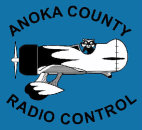|
- DO NOT DRIVE ON THE SOD UNDER ANY CONDITIONS. Walk out to get your plane.
- FREQUENCY CONTROL PROCEDURES:
- You may not have your transmitter on the flight line unless your membership card is clipped to the correct square of the frequency board.
- Guests must clip their current AMA membership card to the board.
- You may occupy a given frequency for a maximum of 15 minutes, after which you must give it up to someone who wishes to use the same frequency.
- When you place your transmitter in the impound rack remove your membership card from the frequency clip that you were using.
- Only AMA and FCC authorized frequencies are allowed at the field.
- Impounding of transmitters will be required at all organized events such as contests, fun flies and fly-ins.
- Pilots and guests must have a current AMA membership and the proper FCC license, where required.
- All non-Spread Spectrum transmitters must display the proper channel numbers.
- The AMA channel designation plan is recommended.
- All aircraft must display the owner’s AMA number or have the owner’s name and address in or on the model.
- Visitors are welcome, but flying is restricted to ACRC members and their guests.
Spectators are not permitted in the flying area and must stay west of the pit area.
- An expansion muffler is required on all engines larger than .049 cu. in.and must comply with the ACRC sound limit of 100 dB.
Sound will be measured using AMA guidelines for meter setup and distance.
No engines may be run before 9:00 AM on Sunday mornings.
- Pilots must fly from designated pilot stations at all times. These pilot stations may be changed for club-sanctioned events.
The 5 pilot stations by the downwind half of the runway will be the stations in use.
On a calm day or when there is a 90 crosswind, the default direction for take-offs and landings shall be to the north and the 5 pilot stations on the south side of the center taxiway shall be used.
This rule implies that a maximum of 5 aircraft will be flying at one time and only one set of 5 pilot stations will be used at one time.
- All Flying Shall be East of the Infinite Flight Line Define by the West Edge of the Asphalt Runway.
Except when flying over the fields to the north and south of the ACRC field, for takeoffs and landings in crosswind conditions,
- When student pilots are receiving instruction all high-speed passes and aerobatics maneuvers shall be done in the in the vicinity of the ditch east of the runway or to the east of that ditch.
(See ACRC FLYING SITE COURTESY, #2, for more information.
- ALL AIRCRAFT MUST BE STARTED FACING THE RUNWAY. High RPM runups will not be made in the pits. The pits are defined as the west half of the area between the spectator area and the fence.
The aircraft should be moved to the area between the pits and the fence for high RPM runups and needle valve adjustments. Run-ups are prohibited directly behind pilots.
POWERED MODELS MUST BE RESTRAINED IN SOME WAY, EITHER BY A HELPER OR MECHANICALLY.
- There will be no taxiing back to the pits, all returning aircraft must have their engines killed before crossing the pilot line.
The pilot line is defined as a line that runs the length of the field through the pilot stations.
There should be no taxiing west of the safety fence. In the area west of the safety fence, all aircraft should be carried or be under some sort of physical control.
- Except for emergency landings, all take-offs and landings will be made on the asphalt runway or on the grass area directly east of the asphalt runway surface. This includes hand launches.
Dead stick landings have priority over all other landings and takeoffs. All emergency landings, including “Deadstick Landings”, will be called out Loudly and Clearly.
- No alcoholic beverages are allowed in the flight area. AMA safety regulations prohibit any flying after the consumption of alcohol or drugs.
- All members are responsible for keeping the area clean. Take your trash with you. Don’t be afraid to pick up after a member not quite as neat and clean as you are.
- If you are using a gasoline-powered engine, you are required to have a fire extinguisher at your pit station.
- Any violations of these rules and any unsafe flying should be reported to the Field Safety Officer or to the Board.
|






